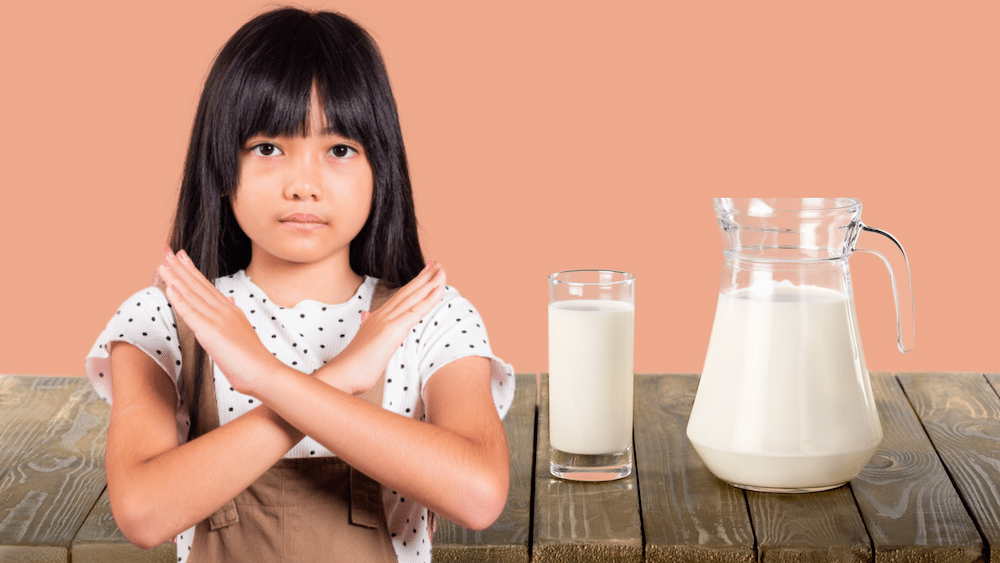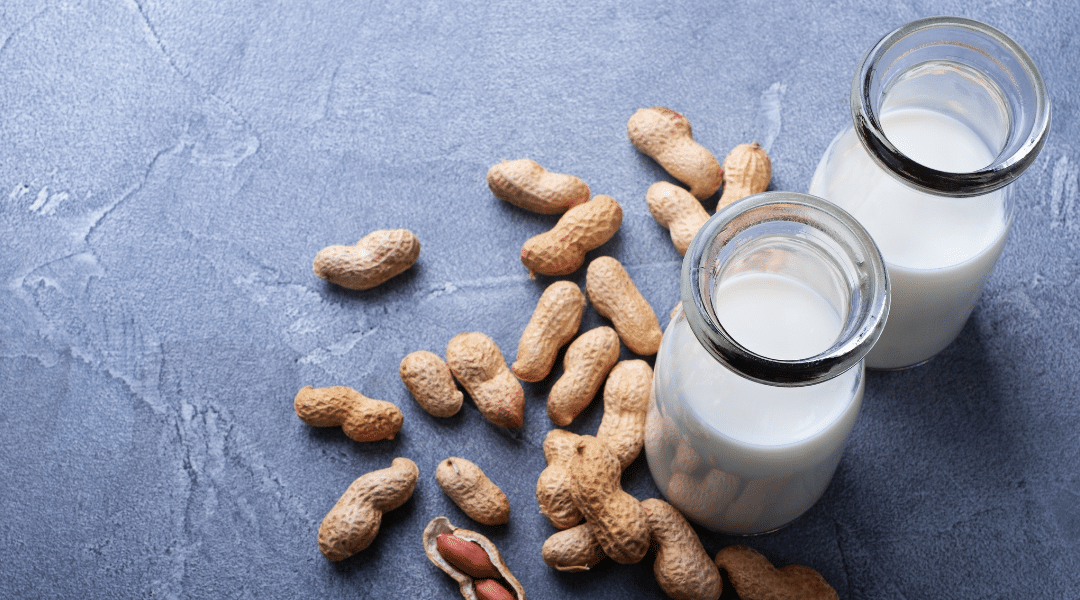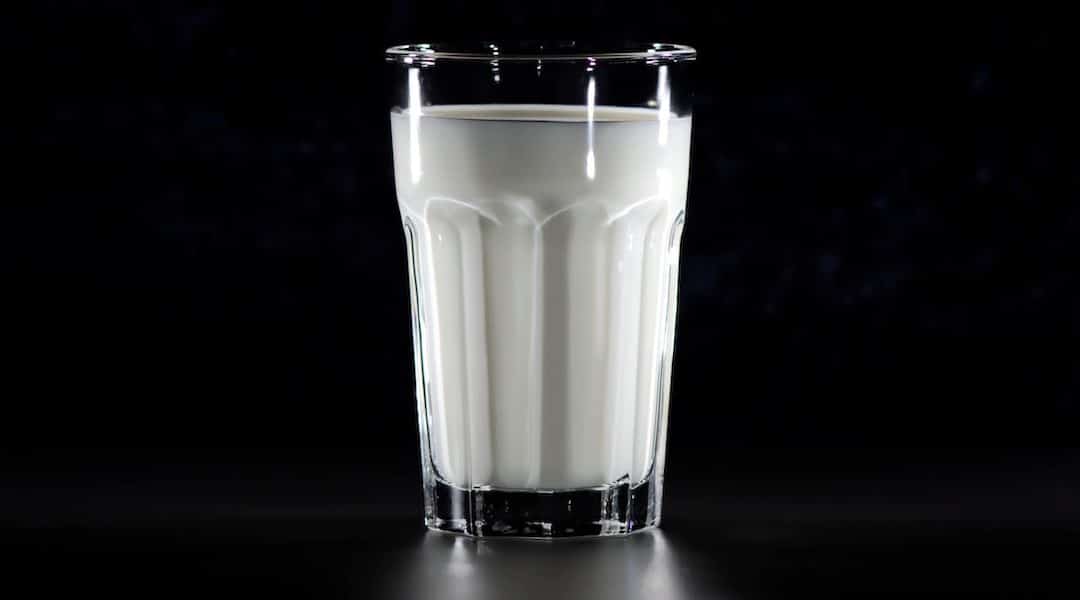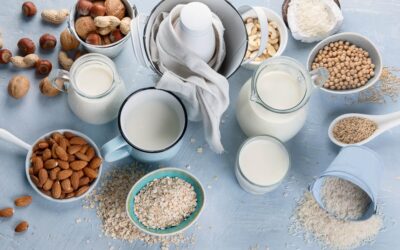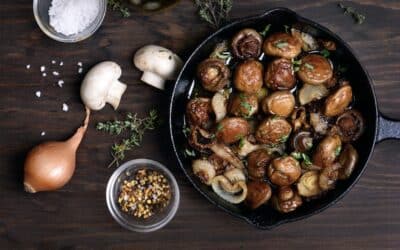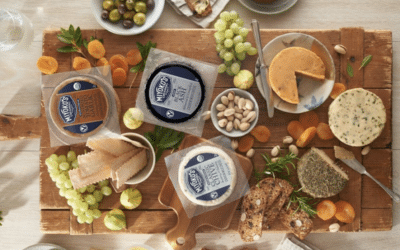The dairy industry is pushing hard to market its products to kids. It entices children with flavored milks and hands-on foods like string cheese, and it attempts to sway parents into buying these products under the guise of nutrition. However, dairy is not a health food—no matter what vitamins it is fortified with or what the national MilkLife commercials say. In children, regular consumption of dairy can lead to acne and eczema, exacerbated asthma symptoms, and increase the risk of obesity and type 2 diabetes as they grow into adulthood (learn more here). Most parents know it isn’t easy convincing a kid to try something new, and it’s even more challenging to take a favorite food away. To avoid tantrums, we’ve created a list of kid-approved dairy-free foods to make the transition a fun journey instead of an uphill battle. Keep reading to learn why milk doesn’t benefit any child, then once you’re reassured, discover the easy, affordable swaps you can make.
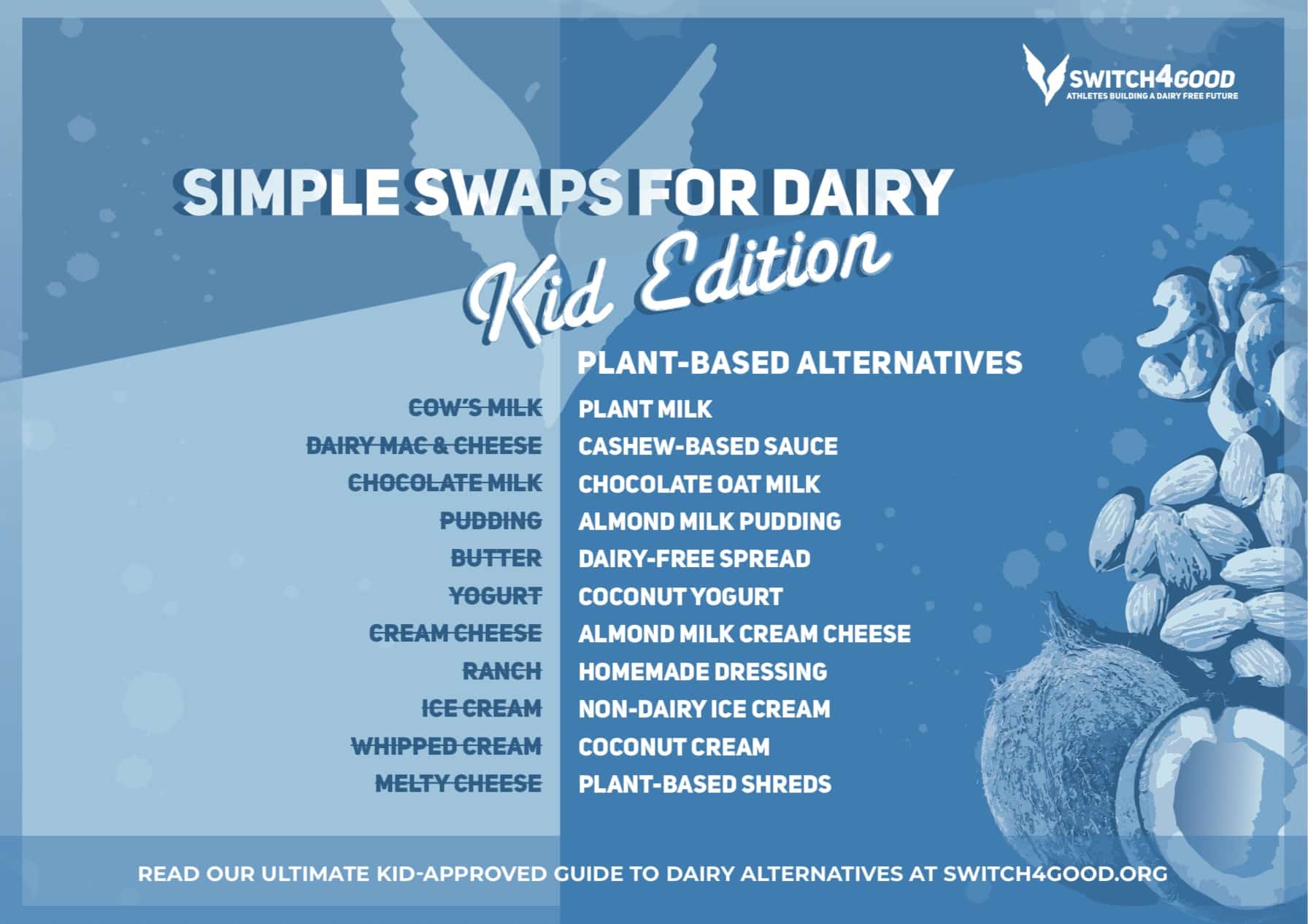
Health Information
Some Stats
- Cow’s milk naturally contains several harmful components including bovine sex hormones, trans and saturated fats, sugars that humans cannot digest, and proteins that are both highly allergenic and act like opiates.
- Cow’s milk is the most severe food allergen in children, resulting in more anaphylaxis hospital cases than peanuts, according to a 2021 pediatric study.
- According to Harvard researchers, the prevalence of acne in teenage boys was 19% greater in boys drinking more than 2 cups of skim milk per day and 44% greater in girls.
- 8-year-old boys who were given skim milk for just one week more than doubled their insulin production, increasing their risk for type 2 diabetes.
- Regular consumption of cow’s milk in adolescence has been linked to a threefold increased risk of advanced prostate cancer.
What about my child’s bones and muscles?
While calcium and protein are essential for growing strong bones and muscles, cow’s milk is not the best place to get it. The calcium in cow’s milk is only 33 percent bioavailable and has a high amount of phosphorus, which some suggest may trigger calcium resorption from the bones when consumed in excess. This reabsorption may make bones brittle over time. Additionally, milk contains D-galactose—a sugar that promotes oxidative stress and inflammation—which is linked to loss of muscle and bone.
Meanwhile, fruits and vegetables have been shown to strengthen bones. In fact, many plant foods are high in bioavailable calcium. The calcium found in almonds, tahini, kidney beans, and most dark leafy greens is over 50 percent bioavailable to the human body. This means that while there may be less overall calcium in certain plant foods in comparison to cows’ milk, the body absorbs far more of it. One cup of kale, for example, has as much bioavailable calcium as one cup of cows’ milk. Put that kale in a fruity smoothie and your kid will drink it down.
Switch4Good dietitian, Matt Ruscigno, says “There is no nutritional need for cow’s milk; humans are the only mammals who drink milk as adults or from another species. The nutrients in milk—namely calcium and protein—can easily be found in plant foods.”
Simple Dairy-Free Swaps
Swap Cow’s Milk for Pea Milk
For dousing morning cereal or drinking straight from the glass, pea milk is a far superior option to cow’s milk. Pea milk naturally contains 8 grams of plant-based protein—the same amount as cows’ milk. You can find Ripple pea milk in most supermarkets and specialty health food stores. Flavors come in unsweetened, vanilla, and chocolate, and they even make shelf-stable lunchbox-sized cartons.
Other notable options: Soy milk (8 grams of protein) and oat milk (creamy, delicious, and fortified with 50 percent of the recommended daily vitamin B12).
Swap Dairy Mac & Cheese for Cashew-Based Sauce
Skip the blue box and treat your child (and yourself) to a homemade pot of mac & cheese using cashews to replicate a creamy, cheesy base. Just like the box, this recipe requires minimal ingredients, and you can make it in a flash. This recipe contains almost 30 grams of protein and 13 grams of fiber in one serving! Alternatively, check out these dairy-free boxed options—just add nondairy butter and milk: Modern Table, Daiya, Annie’s Vegan Mac, and Pastabilities Vegan Organic Mac ‘N Cheese.
Other notable/nut-free options: Bean-based sauce (packed with protein!), nutritional-yeast-based sauce (aka “noochy noodles,” an excellent source of B-vitamins), or veggie-based sauce (made from vitamin-rich butternut squash).
Swap Chocolate Milk for Chocolate Pea or Oat Milk
Oat milk is chocolatey and super creamy but without the excess sugar of chocolate-flavored cow’s milk. Our favorite brand is Oatly, which is available at Whole Foods and other specialty stores. It contains 25% of daily calcium, 50% daily vitamin B12, 20% of daily vitamin D, and 11% daily fiber. Now that’s balanced nutrition.
Other notable options: Chocolate soy milk for a little extra protein.
Swap Pudding for Almond Milk Pudding
Exchange this classic lunchbox go-to for a dairy-free treat. An easy swap is to buy almond milk pudding cups at your local health food supermarket such as Whole Foods or Sprouts. Look for Zen Almondmilk Chocolate Pudding in stores or purchase them on Amazon. For dry pudding packets you mix with plant milk, try Simply Delish in Vanilla, Chocolate, and Strawberry. Your kid won’t know the difference!
Other notable options: Make your own! We love this decadent raw chocolate avocado mousse recipe and this chocolatey peanut butter version as well.
Swap Butter for a Dairy-Free Spread
Have a kid that loves to bake? Make memories in the kitchen by swapping out dairy butter for nondairy butter. Both Melt and Flora use ethically-grown, sustainable palm oil to make their creamy, dreamy plant-based butters, while Miyoko’s Kitchen makes its dairy-free butter without palm oil. All can be used as a one-for-one swap for dairy-based butter.
Other notable options: Many baked goods can be made with neutral-flavored vegetable oil (we recommend safflower), and you can swap in olive oil for butter in many savory dishes, including bechamels, gravies, pasta dishes, and more.
Swap Yogurt for Coconut or Oat Yogurt
Most “kid” yogurt is packed with sugar and artificial colors and flavors. Even some “adult” yogurts act more like dessert than breakfast. Coconut yogurt is rich, creamy, and flavorful, without all that sugar. We love CocoYo, which has billions of live probiotics. It comes in Pure, Raspberry, Ginger Turmeric, and Vanilla flavors.
Other notable options: For kids that love drinkable yogurts, try Forager Project Kids Cashewmilk Yogurt pouches. GoGurt also released a nondairy option—with the same branding your kid really won’t notice the difference.
Swap Cream Cheese for Almond or Cashew Milk Cream Cheese
If your kid can’t get enough bagel and schmear, swap out the saturated fat-filled dairy cream cheese for a plant-based variety, like Kite Hill or Treeline. Flavors come in plain, chive, and jalapeno. Miyoko’s Creamery even makes a cinnamon raisin cream cheese!
Nut-free option: Try the Tofutti brand.
Swap Ranch for Plant-Based Ranch
Hidden Valley—the ranch brand that got us all hooked—makes a dairy- and egg-free dressing called Plant Powered Ranch, making this swap a no-brainer. Same brand, same taste, just more wholesome ingredients. Several other store-bought brands also carry vegan ranch including Daiya and Follow Your Heart.
Other notable options: While opening a bottle is as easy as it gets, making your own dressing isn’t much more difficult. Just blend a few plant-based ingredients with some herbs, and you’ve got a dairy and preservative-free dip! Try this recipe from The Minimalist Baker, or this one for a nut-free version. Flavored hummus or baba ganoush are also stellar (and healthy) alternatives.
Swap Ice Cream for Nice Cream
Did you know that frozen bananas magically turn into soft-serve when blended? Simply peel, chop, freeze, and blend overripe bananas in a high-speed blender until they reach a creamy consistency. You can then flavor this “soft-serve” mixture with your child’s favorite ingredients, such as peanut butter, cocoa powder, cinnamon, or a touch of mint extract.
Other notable options: Most stores carry a full freezer case of dairy-free ice cream pints. So Delicious Cashew Milk, NadaMoo!, Eclipse, and Ben & Jerry’s Non-Dairy are all kid-approved!
Swap Whipped Cream for Coconut Cream
Adults and kids alike love their whipped cream, whether that’s sprayed directly out of a canister or dolloped on top of a special ice cream sundae or a cup of cocoa. Thanks to the boom in the dairy-free consumer trend, there are plenty of nondairy whipped topping options to choose from. For the classic straight-out-of-the-can feel, opt for Reddi Wip’s Nondairy Coconut or Almond-based varieties. If you’re a Cool Whip family, swap the dairy tub for So Delicious’ CocoWhip. No one will taste the difference.
Other notable options: Make your own! Nondairy whipped cream only requires three ingredients: coconut milk, powdered sugar, and vanilla. Chill a can of full-fat coconut milk overnight, scoop out the solid portion and reserve the liquid for later use. Whip the solids with 1 ½ – 2 cups of powdered sugar (or to taste) until the mixture takes on a whipped cream consistency, then fold in a drop or two of vanilla. For more detailed instructions, follow this coconut whip step-by-step.
Swap Melty Cheese for Plant-Based Shreds
Pizza? Grilled cheese? Burritos? Kids love that gooey, pull-apart sensation that cheese offers. Thankfully, there are several high-quality dairy-free cheese options that are widely available in most major supermarkets. Nabati, Follow Your Heart, and So Delicious all make nondairy cheese shreds that melt and taste like dairy cheese, and try Miyoko’s Kitchen brand for standout melty mozzarella.
Other notable options: Hummus. It’s a healthy alternative if you want to stay away from processed food, and it adds a creaminess to a variety of dishes. It’s also high in calcium since it’s made with tahini (a calcium-rich and bioavailable food). Slather it on sandwiches, quesadillas, and even pizza! Try this standout homemade hummus recipe by From My Bowl, or opt for the store-bought variety. We personally love Hope Foods and Roots Hummus, but store brands work as well!
Swap Processed Bars for Dairy-Free Snack Bars
There’s nothing like the convenience of a bar—with no prep required, kids can toss it in a backpack or help themselves to a no-prep snack after school. Many bars on the shelves contain hidden dairy (virtually anything with chocolate chips or a chocolate coating is likely to have some milk derivative). For a simple swap, keep Tosi bars on hand. These minimal-ingredient nut bars will fill them up and keep the grumpy hangries at bay. For a nut-free option, try Enjoy Life bars or Clif Kid ZBars.


